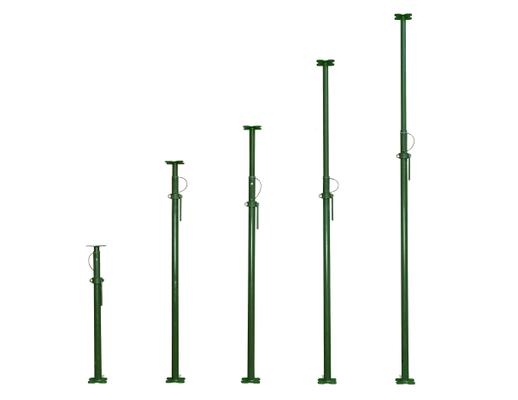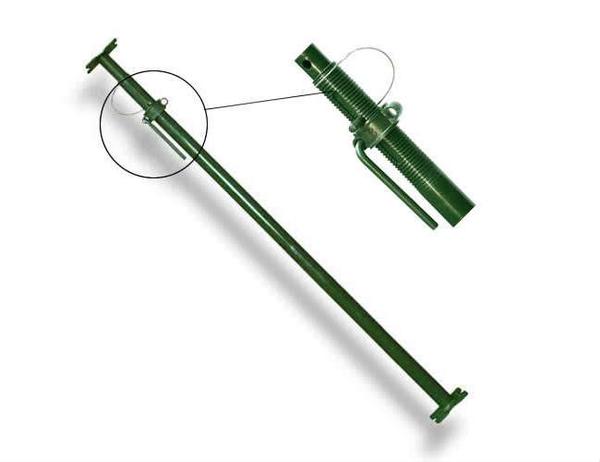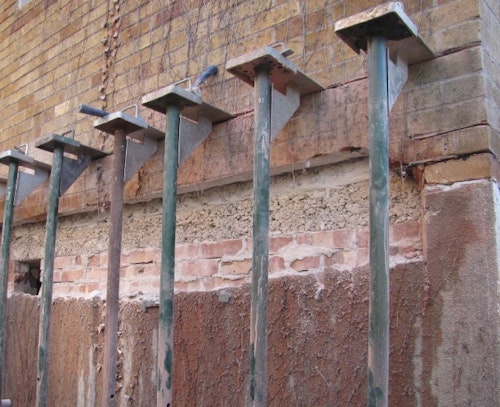Subscribe to our newsletter
Sign up for the latest news & offers from SafeSite
Quick and competitive quotes. Nationwide coverage
Quick quotes. Nationwide coverage
Acrow props, are a vertical support system which is used to support overhead loads. Until they were introduced to the industry in the 1990s, the industry was struggled without them, using instead wooden props and scaffolding. Now, acrow props are an industry staple item which are widely available and seen on all UK construction and building work sites. The wooden prop alternative was simply thwarted with issues. The wood had to be cut to fit each time and largely only survived one job before being disposed of, these were not cost-efficient nor safe, as they were also vulnerable to fire and damp.

Swiss-born William de Vigier, recognised the problems of using wooden props. Soon after arriving in London in 1935, he set about inventing a more cost and work-efficient prop made of steel, which adjusted telescopically using a screw thread design. De Vigier named his product acrow props, after his business solicitor Mr. A Crow, to make his product both easy to pronounce and easy to identify at the start of alphabetical listings.
The steel strength of his acrow props, was not immediately well received by traditionalists within the building industry. Sir Robert McAlpine quickly recognised that being able to use the same props time and again offered real time and money saving potential. His company, the already famous McAlpine & Sons, began to buy and use acrow props to save costs and to maximise efficiency, as well as safety, on his construction sites.
The McAlpine orders set the new standard for others and larger orders began flooding in: in the four short years from 1935 to 1939, over 40,000 acrow props came into daily use across building and construction sites in the UK.

De Vigier’s overall design was developed to create a steel product which offers increased strength and durability, whilst also being safe, efficient, reliable and economical for building companies to use. As such, the design has changed little since its invention, with a modern design including:
Each prop’s threaded element is fully friction welded to the outer tube for maximum strength whilst retaining the full tube thickness without adding additional weight. There are 5 different sizes of acrow prop available, each fully adjustable to meet a range of height and load-bearing needs.
De Viglier’s purpose of cost-efficiency continues to this day. Today’s galvanised steel construction of acrow props offers increased durability in all cases but is particularly suited to damp environments as the galvanised finish offers enhanced protection against corrosion. Additionally, as acrow props are now widely used in the UK, spare parts are available, adding to their cost-efficiency as parts rather than whole props can be replaced as needed.

As a vertical support product, acrow props can be used in scaffolding, or for direct support when:
Providing the vertical strength and base from which additional support products can be added, acrow props also offer compatibility with other support products, making them versatile, cost effective to use and time-effective to install and adapt as work progresses. acrow props are fully compatible for being used in combination with:
The relative lightweight of acrow props also makes them time-efficient to use, as they offer easy portability for quick installation by one person.
All acrow props are manufactured in compliance with safety standard BS4074 and offer a good safety record. However, as with most tools, safety relies on them being used and installed properly. When using acrow props, additional consideration should be given to:
Load bearing:
Siting and installation:
As acrow props offer overhead support by standing firm below, it’s essential to check that the points of contact for the prop are fit for purpose before setting up the acrow prop. The ground, wall masonry and roof / ceiling timbers must be:
Additionally, props should be positioned carefully and installed properly to prevent them from being knocked or displaced. acrow props should always be installed vertically (with a difference of no more than 1.5o off vertical line).
Work in progress:
Once installed, props need to be checked regularly throughout use to ensure they have not become loose over the course of the work, as props can be particularly vulnerable whilst the wall is being opened up. At the very least, props should be checked by project workers before starting work and again at the end of each work session and also be inspected thoroughly by a competent professional at least once weekly.
As work progresses, continue to be aware of the safe working load for the relevant size prop. This load should not be exceeded and it’s important to be aware of how this load may change as phases of work progress.
At all stages, including installation and use, additional safety equipment such as hard hats and safety gloves should be used when working with acrow props. Electrical cables or lighting should not be added to the props.
We are happy to offer guidance on using acrow props, but as working with load-bearing structures offers a high degree of risk. A structural engineer and competent person should be involved in all aspects of using acrow props from load bearing calculations to installation. We are experts in safe and effective construction work and welcome contact at any stage to advise on the right solution to suit your needs.
We respond in under 30 mins on average (excl. weekends)